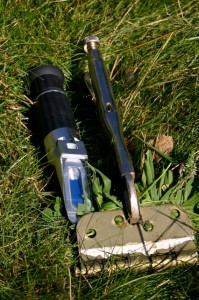We’ve got a new tool on the farm–a refractometer! We aren’t checking grapes for wine harvest-ripeness, but rather the grass for “Total Dissolved Solids” or TDS (for short).
The refractometer gives readings in degrees Brix (°Bx), which corresponds to the % of sugar in the tested liquid (there’s more in there than just sugars, hence the “total dissolved solids” tag). The higher the number, the sweeter the juice. Our new instrument was purchased from a friend for $65. I did a quick test with filtered water and it showed an appropriate 0°, so Abigail and I spent some time Sunday afternoon out testing everything we could think of.
Dr. Dettloff demonstrated this for us during his seminar day, and Kathy and I were running all over the farm collecting samples of grass for testing. He carried a vise-grip specially modified with a stainless steel “beak” that collects and directs the drops of expelled sap to its tip for collection. He explained how a farm needs to get his pasture up to above 10° Brix, in order to keep his animals healthy and strong.
That threshold of 12° Bx marks the point when insects stop eating the plants. The theory goes that if an aphid or caterpillar eats sap sweeter than that, it ferments into alcohol and kills the bug.
My first attempt at getting the grass to release its sap was not a success. Regardless of how I bruised and rolled the grassy blades, my vise grip was just too narrow to coax a drip of sap to form. Hmmm…. I then was hit with a brilliant idea and ran to the garage to rummage through my stash of “stuff left over from other projects”, and returned with a heavy 4″ door hinge. It worked! It isn’t pretty, but a vise grip crushing a ball of greens inside the hinge plates reliably yields a drip or two of sap. Here are our results:
Rainier cherries = 26° Bx
Lush grasses from ungrazed places = 5° Bx
Tall grass next in line for grazing rotation = 2° Bx
Grass on poor soil, but still green enough to pull sap out of = 1 – 2° Bx
Green tips on Himalayan Blackberry plants = 16° Bx
Conclusion:
-
Take the goats off of the grass and move them to where they can reach the blackberry vines!
-
Start amending the soil to grow better grass. Most likely the first thing on the list will be spreading crushed limestone…standby for future news after our soil test comes back.
We’ve got a long way to go before we get to that magical threshold of 12° Bx, but I’m excited to be able to gauge our progress now that I’ve got a tool to do it!

